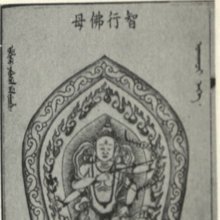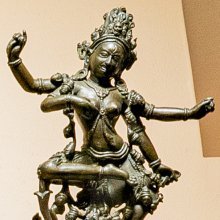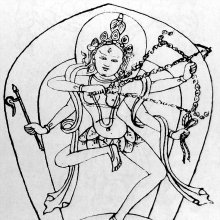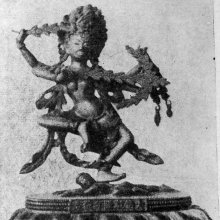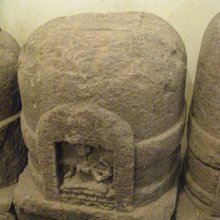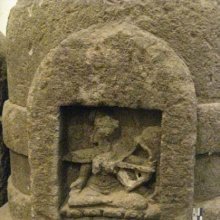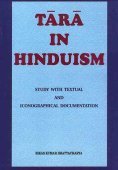Kurukulla, Kurukullā: 9 definitions
Introduction:
Kurukulla means something in Buddhism, Pali, Hinduism, Sanskrit, Jainism, Prakrit. If you want to know the exact meaning, history, etymology or English translation of this term then check out the descriptions on this page. Add your comment or reference to a book if you want to contribute to this summary article.
Images (photo gallery)
(+8 more images available)
In Hinduism
Shaktism (Shakta philosophy)
Source: Google Books: ManthanabhairavatantramKurukullā (कुरुकुल्ला) refers to one of the nine Nityās (Yoginīs particularly concerned with Kāma), according to the Manthānabhairavatantra, a vast sprawling work that belongs to a corpus of Tantric texts concerned with the worship of the goddess Kubjikā.—Accordingly, “Kulanityā is the first and Vajreśvarī is the second. The third is the Nityā Tvaritā and the fourth is Kurukullā. The goddess Lalitā is the fifth and the sixth is called Bheruṇḍā. The seventh is Nīlapatākā and the eighth is Kāmamaṅgalā. The goddess Vyomavyāpinī, who bestows accomplishment, is the ninth. O Lord of the gods, once known Tripurā, on (her) red lotus seat by means of the liturgy of the Nine Nityās recollect (her) liturgy (krama)”.
Source: Kamakoti Mandali: The Yoginis of Narasimha VyuhaKurukullā (कुरुकुल्ला) refers to one of the various Nṛsiṃha Yoginīs or Śaktis created for the purpose of pacifying the Rudraśaktis.—Accordingly, [...] Rudra meditated on Mahānṛsiṃha. Pleased with Rudra’s prayers, Narasiṃha created four Vyūhaśaktis [Vāgīśvarī, Mahāmāyā, Bhagamālinī and Atibhadrakālī=Śuṣkarevatī]. The Lord created a group of Nṛsiṃha Yoginīs [viz., Kurukullā] to accompany the three main Śaktis. All of them, under the command of Śuṣkarēvatī, attacked the Rudraśaktis, subdued them and pacified them to attain benevolence.

Shakta (शाक्त, śākta) or Shaktism (śāktism) represents a tradition of Hinduism where the Goddess (Devi) is revered and worshipped. Shakta literature includes a range of scriptures, including various Agamas and Tantras, although its roots may be traced back to the Vedas.
In Buddhism
Tibetan Buddhism (Vajrayana or tantric Buddhism)
Source: Wisdom Library: Tibetan BuddhismKurukulla (कुरुकुल्ल) is the name of a Śrāvaka mentioned as attending the teachings in the 6th century Mañjuśrīmūlakalpa: one of the largest Kriyā Tantras devoted to Mañjuśrī (the Bodhisattva of wisdom) representing an encyclopedia of knowledge primarily concerned with ritualistic elements in Buddhism. The teachings in this text originate from Mañjuśrī and were taught to and by Buddha Śākyamuni in the presence of a large audience (including Kurukulla).
Source: archive.org: The Indian Buddhist IconographyKurukullā (कुरुकुल्ला) refers to one of the various (female) emanations of Amitābha having their Sādhana described in the 5th-century Sādhanamālā (a collection of sādhana texts that contain detailed instructions for rituals).—Kurukullā is said to confer success in the Tantric rite of Vaśīkaraṇa or the rite of enchanting men, women, ministers, even kings. [...] The mantra of Kurukullā is “Oṃ Kurukulle Hūṃ Hrīḥ Svāhā”. When this mantra is muttered ten thousand times, all men are bewitched. Thirty thousand times would prove sufficient to subdue a minister, but the subjugation of a king requires no less than a lakh. Kurukullā can even confer on her devotees the power of subduing all ministers and kings.
There are various Sādhanas for different forms of Kurukullā described in the Sādhanamālā:
- Śukla-kurukullā (two-armed, white colour),
- Tārodbhava-kurukullā (four-armed, red colour),
- Uḍḍiyāna-kurukullā (four-armed, red colour),
- Aṣṭabhuja-kurukullā (eight-armed, red colour),
- Māyājālakrama-kurukullā (six-armed, red colour).
Kurukullā as an emanation of Amitābha of red colour generally assumes the red colour, but when two-armed, she has, according to the Sadhānamālā the white colour. [...] Strictly speaking, only those deities can be called Tārās to whom the mantra: “oṃ tārā tuttāre ture svāhā” is assigned. [...] From the colour of the different Tārās it will be possible to refer them [viz., Kurukullā] to their respective Kulas or families presided over by the five Dhyāni Buddhas. [...] There are not many Red Tārās in the Sadhānamālā, Kurukullā being the only one belonging to the red variety. As she bears the image of Amitābha on the crown, she inherits from him as his emanation, her red complexion.

Tibetan Buddhism includes schools such as Nyingma, Kadampa, Kagyu and Gelug. Their primary canon of literature is divided in two broad categories: The Kangyur, which consists of Buddha’s words, and the Tengyur, which includes commentaries from various sources. Esotericism and tantra techniques (vajrayāna) are collected indepently.
In Jainism
General definition (in Jainism)
Source: academia.edu: Tessitori Collection IKurukullā (कुरुकुल्ला) refers to a “well-known deity in Buddhist tantra”, according to the Kurukullāstavana (dealing with early teachers, Gods or Goddesses), which is included in the collection of manuscripts at the ‘Vincenzo Joppi’ library, collected by Luigi Pio Tessitori during his visit to Rajasthan between 1914 and 1919.—Kurukullā is a well-known deity in Buddhist tantra and attempts were made to introduce her in the Jain pantheon in the middle ages according to u.p. Shah, Jaina-Rūpa-Maṇḍana, 1987, p. 64. The end closes with a colophon phrase stating that this was the composition of Vādidevasūri. The editor quotes a Sanskrit story from a manuscript of the Upadeśasaptatikā by Somadharmagaṇi that was got to be printed by the Ātmasabhā. Kurukullā appeared one night and defeated a Yogi who had been oppressing people with snakes.

Jainism is an Indian religion of Dharma whose doctrine revolves around harmlessness (ahimsa) towards every living being. The two major branches (Digambara and Svetambara) of Jainism stimulate self-control (or, shramana, ‘self-reliance’) and spiritual development through a path of peace for the soul to progess to the ultimate goal.
Languages of India and abroad
Sanskrit dictionary
Source: Cologne Digital Sanskrit Dictionaries: Edgerton Buddhist Hybrid Sanskrit DictionaryKurukulla (कुरुकुल्ल).—(-parvata) , name of a mountain: Sādhanamālā 343.11 etc.
Source: Cologne Digital Sanskrit Dictionaries: Monier-Williams Sanskrit-English DictionaryKurukullā (कुरुकुल्ला):—f. ([from] ru-kulyā, ‘belonging to the Kuru race’ ?), Name of a Buddh. deity.
[Sanskrit to German]
Sanskrit, also spelled संस्कृतम् (saṃskṛtam), is an ancient language of India commonly seen as the grandmother of the Indo-European language family (even English!). Closely allied with Prakrit and Pali, Sanskrit is more exhaustive in both grammar and terms and has the most extensive collection of literature in the world, greatly surpassing its sister-languages Greek and Latin.
See also (Relevant definitions)
Starts with: Kurukullaka, Kurukullamantra, Kurukullastavana, Kurukullavidya.
Ends with: Ashtabhujakurukulla, Hevajrakramakurukulla, Kalpoktakurukulla, Mayajalakramakurukulla, Shuklakurukulla, Tarodbhavakurukulla, Uddiyanakurukulla, Upakurukulla.
Full-text (+11): Kaurukullaka, Hevajrakramakurukulla, Kalpokta, Hevajrakrama, Kalpoktakurukulla, Hevajra, Kurukullaka, Tarodbhavakurukulla, Tarodbhava, Uddiyanakurukulla, Mayajalakramakurukulla, Kurukullastavana, Bherunda, Haramekhala, Kulavidya, Nityamadadrava, Shuklakurukulla, Vajreshvari, Nilapataka, Kulanitya.
Relevant text
Search found 8 books and stories containing Kurukulla, Kurukullā; (plurals include: Kurukullas, Kurukullās). You can also click to the full overview containing English textual excerpts. Below are direct links for the most relevant articles:
The Indian Buddhist Iconography (by Benoytosh Bhattachacharyya)
Figure 121-122 - Emanations of Amitābha: Kurukullā
Figure 192 - Emanations of Ratnasambhava: Prasannatārā (Prasanna Tārā)
The Practice Manual of Noble Tārā Kurukullā (by Dharmachakra Translation Committee)
Abhinaya-darpana (English) (by Ananda Coomaraswamy)
Plate II - Kurukullā < [Plates]
Stupas in Orissa (Study) (by Meenakshi Chauley)
Emanations of Amitabha < [Chapter 5]
Uddiyana Pitha (in Tantric Buddhism) < [Chapter 2]
Minor Votive Stupas at Ratnagiri < [Chapter 4]
Varahi Tantra (English Study) (by Roberta Pamio)
Blue Annals (deb-ther sngon-po) (by George N. Roerich)
Chapter 5 - Kālacakra lineage: Piṇḍo < [Book 10 - The Kālacakra]
Chapter 6 - First incarnation series (vii): rol pa'i rdo rje (Karmapa IV) < [Book 8 - The famous Dakpo Kagyü (traditions)]
Related products
